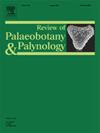Paleoenvironmental and paleoclimatic trends during the early-middle Cenomanian in northeastern Africa (Egypt): Insights from palynomorph and palynofacies analyses
IF 1.7
3区 地球科学
Q2 PALEONTOLOGY
引用次数: 0
Abstract
The early to middle Cenomanian was marked by a predominant greenhouse world, with diminished ice sheets, disruptions in the global carbon cycle, and long-term eustatic sea-level rise, which led to the development of vast epicontinental and shallow shelf seas. These oceanographic and environmental instabilities influenced climate evolution and the associated vegetation communities in adjacent continental regions. During this period, the Tethys Ocean flooded much of North Africa, resulting in the deposition of thick carbonate and siliciclastic sequences. In this study, a detailed palynomorph and palynofacies investigation of twenty-eight cuttings and core samples from the Bahariya Formation in well Salam-17 of the Shushan Basin, north Western Desert (Egypt) was conducted to reconstruct the vegetation ecosystem and its response to climatic and depositional environmental changes during the early-middle Cenomanian. Statistical analysis revealed two distinct clusters of particulate organic matter (POM) components, corresponding to two palynofacies assemblages (PFA-1 and PFA-2). PFA-1, which occurred in most of the samples, is characterized by high proportions of phytoclasts, suggesting deposition in fluvio-deltaic to marginal marine environments. PFA-2 is dominated by high abundances of AOM, revealing a shallow inner shelf environment with limited terrestrial input. A rich assemblage of humidity palynomorph indicators, including fern spores, conifer pollen from Taxodiaceae and Araucariaceae, points to predominantly warm and humid climates during the early-middle Cenomanian. However, the abundant presence of aridity palynomorph indicators, such as gnetalean Elaterates and Ephedroids, along with coniferous Cheirolepidiaceae, in the upper part of the Bahariya Formation indicates a short-lived phase of semi-arid to arid conditions during the late early Cenomanian. The high abundances of megathermic plant communities suggest that a warm climate prevailed throughout the succession. Regional correlations indicate that the warm arid to semi-arid phase is coeval throughout the north Western Desert, corresponding to the early Cenomanian Elaterosporites klaszii Interval Zone.
非洲东北部(埃及)早-中塞诺曼尼亚期古环境和古气候趋势:来自孢粉形态和孢粉相分析的启示
早至中期的Cenomanian以温室世界为主要特征,冰盖减少,全球碳循环中断,海平面长期上升,这导致了广阔的陆表海和浅海的发展。这些海洋学和环境的不稳定性影响了邻近大陆地区的气候演变和相关的植被群落。在此期间,特提斯海洋淹没了北非的大部分地区,导致了厚厚的碳酸盐和硅屑层的沉积。本文通过对埃及西北部沙漠地区苏山盆地萨拉姆-17井巴哈里亚组28个岩屑和岩心样品的孢粉形态和孢粉相研究,重建了早-中塞诺曼期植被生态系统及其对气候和沉积环境变化的响应。统计分析显示,两个不同的颗粒有机质(POM)组分簇对应于两个孢粉相组合(PFA-1和PFA-2)。PFA-1存在于大多数样品中,其特征是植物碎屑比例高,表明沉积在河流三角洲到边缘海洋环境中。PFA-2以高丰度的AOM为主,显示出陆源输入有限的浅层内陆架环境。丰富的湿度形态指标组合,包括蕨类孢子,杉科和针叶树科的针叶树花粉,表明在早中期的Cenomanian主要是温暖潮湿的气候。然而,在巴哈里亚组的上部,大量的干旱发育指示物,如麻叶类和麻黄类,以及针叶类Cheirolepidiaceae的存在,表明在塞诺曼尼亚晚期早期的半干旱到干旱条件的短暂阶段。巨生植物群落的高丰度表明,在整个演替过程中,温暖的气候占主导地位。区域相关性表明,整个西北沙漠的温暖干旱至半干旱阶段是同时期的,对应于早塞诺曼世的Elaterosporites klaszii间隔带。
本文章由计算机程序翻译,如有差异,请以英文原文为准。
求助全文
约1分钟内获得全文
求助全文
来源期刊
CiteScore
3.50
自引率
21.10%
发文量
149
审稿时长
6 months
期刊介绍:
The Review of Palaeobotany and Palynology is an international journal for articles in all fields of palaeobotany and palynology dealing with all groups, ranging from marine palynomorphs to higher land plants. Original contributions and comprehensive review papers should appeal to an international audience. Typical topics include but are not restricted to systematics, evolution, palaeobiology, palaeoecology, biostratigraphy, biochronology, palaeoclimatology, paleogeography, taphonomy, palaeoenvironmental reconstructions, vegetation history, and practical applications of palaeobotany and palynology, e.g. in coal and petroleum geology and archaeology. The journal especially encourages the publication of articles in which palaeobotany and palynology are applied for solving fundamental geological and biological problems as well as innovative and interdisciplinary approaches.

 求助内容:
求助内容: 应助结果提醒方式:
应助结果提醒方式:


